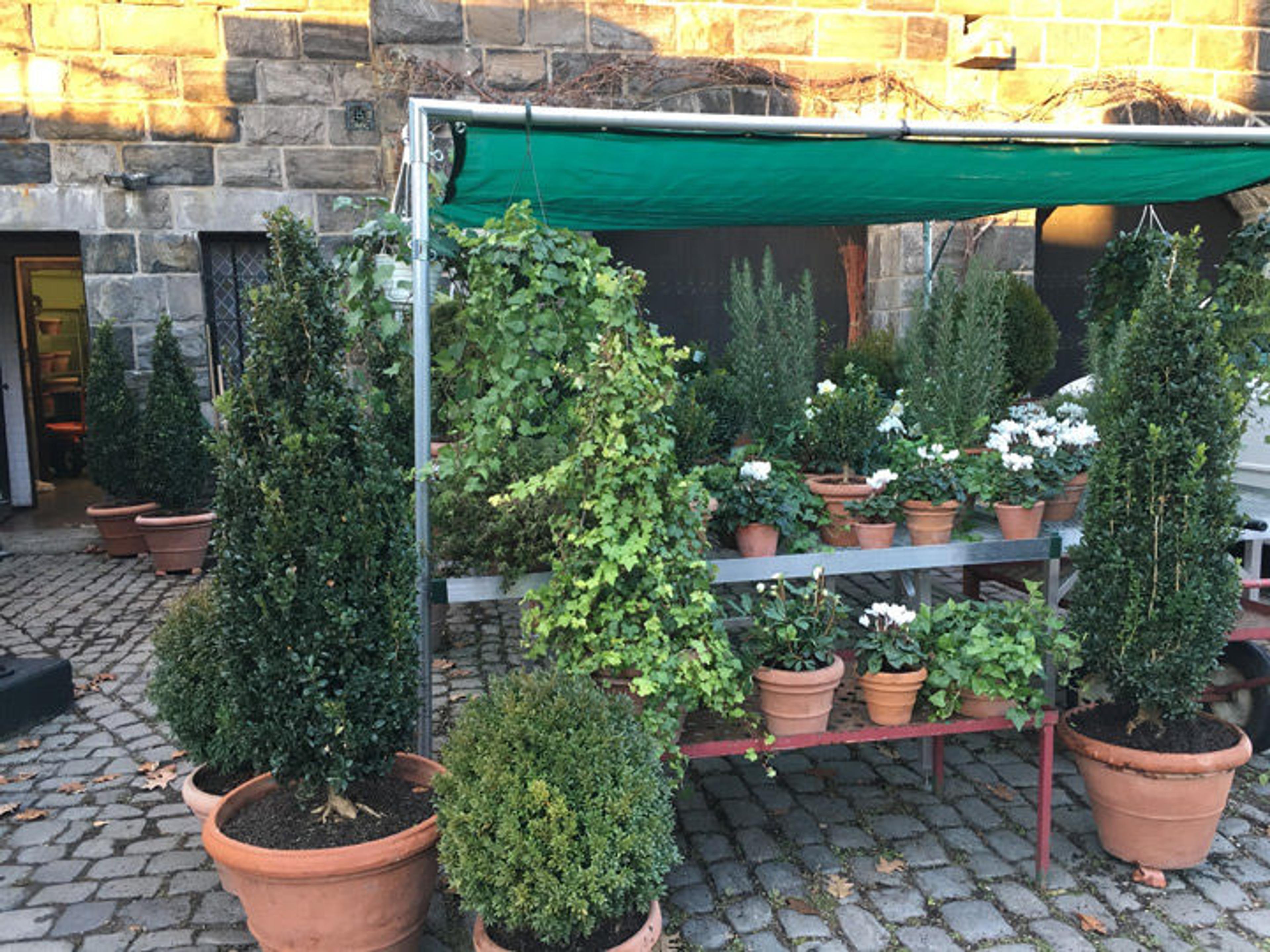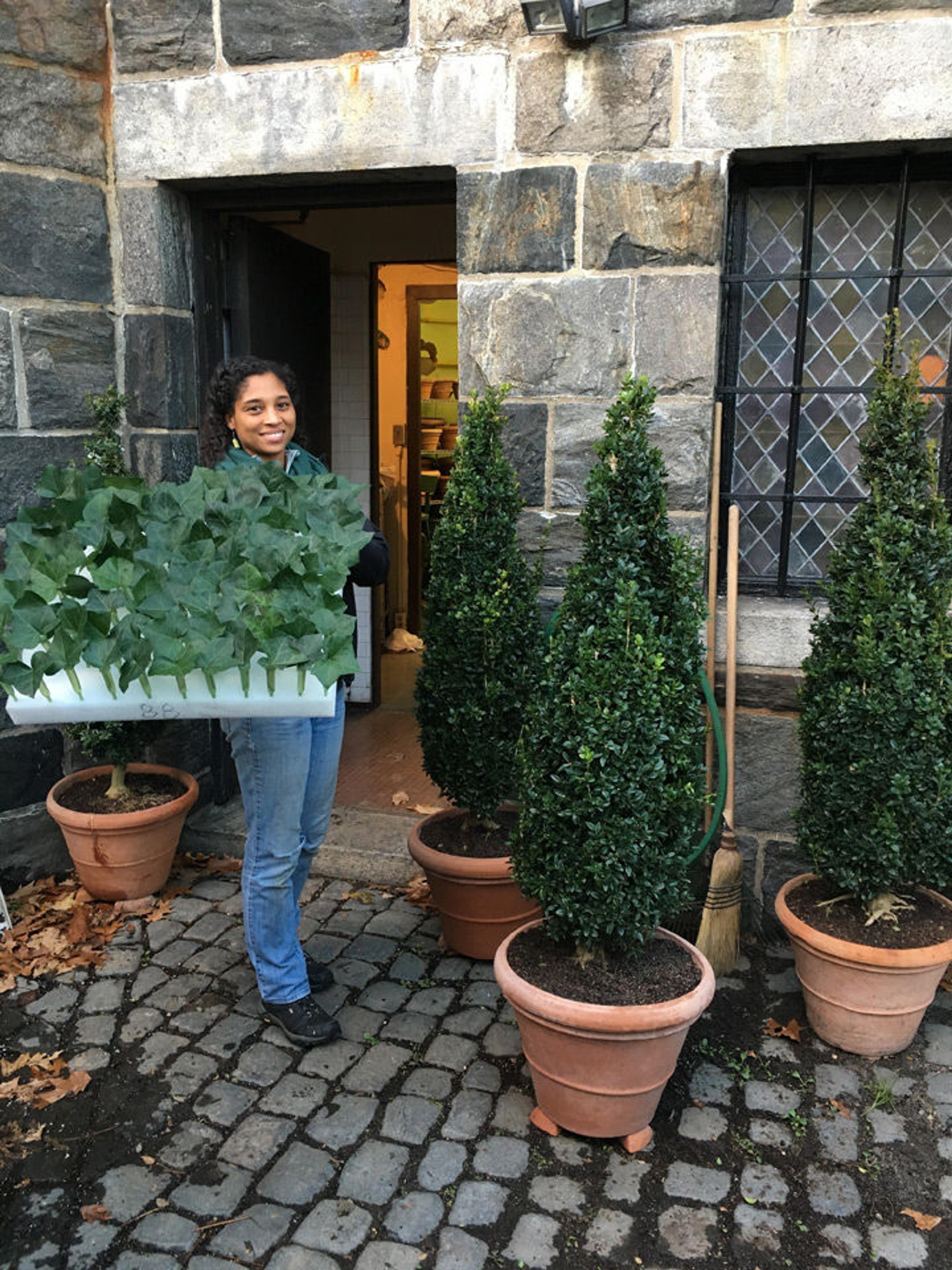The Green of Winter

The gardens workspace plants in preparation for holiday displays. Photos by the author
«Through January 9, 2017, the entryways, cloisters, and halls of The Met Cloisters will be decked with evergreens. This custom is in keeping with a medieval and Met Cloisters tradition.»
The practice of decorating homes and places of worship with plant material as agents of blessing and wards of protection, while common to many cultures, had particular importance for medieval Europeans during the bleak winter months. As an agrarian society, outdoor tasks slowed during the winter and were replaced by activities centered on the hearth. The austerity of the season was sharpened by the bare branches of the temperate deciduous forests. Set against grey skies, evergreen boughs of native trees and shrubs, such as boxwood, holly, and yew, were a welcome sign of life amidst the barren landscape. Brought inside, the greens served as a potent reminder of spring and the promise of eternal life.
The humble and useful boxwood tree (Buxus sempervirens) was cherished for its deep, glossy evergreen foliage. Boughs of box were featured in all significant celebrations and rites of the season, including Christmastide and Easter. Medieval Europeans used box boughs in place of palms for Palm Sunday processions. Similarly, boxwood undergirds our holiday decorations. The great arches that visitors to the Museum pass under are entirely covered with fresh boxwood.

Nuala Outes, dedicated volunteer and holiday decorations expert, covering an arch with boxwood
The familiar English ivy (Hedera helix) also plays a significant role in our holiday decorations. Our good neighbors, Fort Tryon Park, generously allow us to harvest copious quantities of fresh leaves. Approximately 3,000 of the choicest, blemish-free leaves are hand washed, trimmed, and inserted into individual water tubes to preserve them. This year the leaves seemed particularly large and lustrous, perhaps because of the long, mild autumn.

Gardener Yvette Weaver holding ivy from Fort Tryon Park to be used in the holiday decorations
Ivy has a complicated history. For some, ivy's evergreen beauty is enough to warrant its inclusion in the garden. Others find its scrambling and climbing behavior far too aggressive. Likewise in the Middle Ages, the vines were both cherished and decried. Viticulturist and foresters warned against its tendency to smother vines and trees. Because of ivy's association with Dionysus, the plant carried connotations of licentiousness and drunkenness though it was thoroughly Christianized by the Middle Ages and associated with the virgin.

Ivy (Hedera helix) has two distinct forms: mature and juvenile. Juvenile ivy only becomes mature when it has grown vertically for a number of years. If it continues to scramble horizontally, it will remain in its juvenile form. The habit and physical appearance of mature ivy is markedly different from the juvenile form. Its leaves become less lobed and stems more shrub-like. Only mature ivy, like this, will flower and fruit.
Christmastide, the traditional feast spanning the 12 days between the Nativity and the Epiphany, staved off the leanness of winter for medieval Europeans. Apart from liturgical significance, the feasting did much to sustain spirits. It was also an excuse to consume the last of the perishable stores. Our decorations at The Met Cloisters utilize many of the same fruits and nuts that would have made up a conspicuous part of the Christmastide feast. Each of the main hall's arches is filled with clusters of fresh lady apples, rosehips, and hazelnuts. The arcades are filled with fragrant evergreen pots of rosemary, citrus, jasmine, bay laurel, and myrtle and bright with linen-white blooms of hellebores and cyclamen.
Recently an article written by Hildegard Schneider, the first head gardener of The Met Cloisters, was brought to my attention. [1] Hildegard began the December 1945 article with "Each year at Christmas time The Cloisters is decorated with plants grown in its own garden." The article was not only a lengthy discussion of the pomegranate, but also fresh evidence of just how many years The Met Cloisters has been reviving this medieval tradition. All of the decorations are made possible by the generous help of all Museum staff and volunteers. Visit The Met Cloisters to see the culmination of all of our work and celebrate the holiday season.
Note
[1] Schneider, Hildegard. "On the Pomegranate." Metropolitan Museum of Art Bulletin 4, no. 4 (1945): 117–120.
Related Links
MetMedia: Holiday Decorations at The Cloisters (December 23, 2014)
Holiday Guide: Find out more about Holidays at The Met.
Caleb Leech
Caleb Leech is the managing horticulturist at The Met Cloisters.